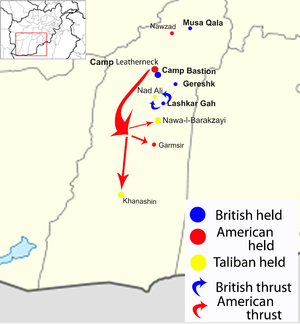Operation Panther's Claw
| Operation Panther's Claw | |||||||
|---|---|---|---|---|---|---|---|
| Part of the Afghan War | |||||||
 Operation Panther's Claw in blue; Operation Strike of the Sword in red |
|||||||
|
|||||||
| Belligerents | |||||||
|
|
|
||||||
| Commanders and leaders | |||||||
|
|
|||||||
| Strength | |||||||
| 3,000 (UK) 650 (ANA) 140 (Estonia) 700 (Denmark) |
500 (British estimate) | ||||||
| Casualties and losses | |||||||
| 10 killed (UK) 12 killed (ANA) 4 killed (Afghan PMC's) |
200+ killed (British claim) | ||||||
Operation Panchai Palang, or Panther's Claw, was a British-led military operation of the Afghan War in Helmand Province in southern Afghanistan. It aimed to secure various canal and river crossings to establish a permanent International Security Assistance Force (ISAF) presence in the area. The Commander of the operation declared the first stage of the operation as a success on 27 July 2009.
Soon after the Taliban insurgency took root in Afghanistan large tracts of Helmand Province came under Taliban control. Of all of Afghanistan's provinces, Helmand "has been the most difficult" for coalition forces, according to BBC News foreign correspondent Ian Pannell, and holds the largest Taliban presence.
British forces deployed to Helmand in 2006, formally assuming responsibility for security in the province from US forces on 1 May 2006. In Helmand, described as "the centre of the Taliban insurgency", they faced heavy combat and regular attacks by Taliban fighters.
According to Pannell, the "latest figures" show that more than 10 attacks took place each day in Helmand Province as of July 2009, and most of the nearly 170 British forces fatalities in Afghanistan since 2001 prior to Panther's Claw were caused by the Taliban in Helmand.
Panther's Claw was preceded by several other operations carried out by British and Afghan government forces with the purpose of "taking and holding ground" in Helmand Province.
Operation Zafar, launched on 27 April, lasted one week and involved more than 200 troops of the Afghan National Army (ANA) and Afghan National Police, supported by elements of the Mercian Regiment and The Royal Gurkha Rifles, respectively. The operation succeeded in clearing the Taliban from several villages around Basharan in central Helmand, killing "many Taliban insurgents" according to the Ministry of Defence (MoD) at a cost of only "handful" of ANA and British casualties.
...
Wikipedia
